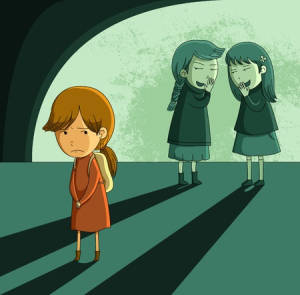By Dr. Ken Broda Bahm:
It is one of the earliest and most heartbreaking tactics that children learn: Because social connections are powerful, taking those connections away is a weapon. So kids are left out, not included, not talked to, ignored. Ostracism from one’s peers may be a passive form of aggression, but it is a painful form all the same. And, like most of the other battles from the playground, it doesn’t end with childhood. Based on some recent research, it continues in the workplace, and it does so at a level that managers and attorneys may not fully appreciate. The research comes from a survey of 3,400 American workers in a number of different types of companies. According to the research, summarized in a recent Psyblog post, active bullying is a problem in the workplace, but the greater problem is ostracism. “Compared with those who had experienced harassment,” the piece concludes, “those being ignored felt more inclined to quit their job, less connection to their job and had a greater number of health problems.”
That implies the need for a broader view of workplace aggression and the full spectrum of factors that can turn someone into a whistle-blower, a plaintiff, or simply an ex-employee. Lawyers, and managers who are informed by lawyers, might be putting most of their focus on active harassment and missing other aspects of a company culture that can be just as destructive, or more so. I can imagine a manager trying to resolve a dispute by saying, “Can’t you just ignore him,” believing that silence means peace and a return to work. But what the research indicates is that silence can be a form of workplace conflict as well, and perhaps the worst form of it. Workplace ostracism deserves to be considered when thinking about harassment, retaliation, constructive discharge, and hostile environment claims. In this post, I will take a look at the research along with a few implications.
The Research: Ostracism as Harassment
The study (O’Reilly et al., 2014) focused on a comparison of overt and active harassment, or bullying, with more subtle forms of ostracizing. The conclusion is that workplace bullying is indeed a big deal. In fact, fully one third of the 3,400 respondents had been bullied at work, and one in five felt they were forced to quit a job due to bullying.
But ostracism emerged as an even greater threat to workplace satisfaction. This was in spite of the perceptions of the respondents, who tended to feel that ostracism is acceptable, particularly if the alternative is bullying. But the ostracized worker tended to feel less connected to work, reported more health problems, and when measured three years after the initial survey, was more likely to have left the job. Interestingly, those who reported being bullied at work were no more likely than other workers to have left, but those who were ostracized had a better chance of being an ex-employee by that point.
As author Sandra Robinson states, “We’ve been taught that ignoring someone is socially preferable — if you don’t have something nice to say, don’t say anything at all. But ostracism actually leads people to feel more helpless, like they’re not worthy of any attention at all.”
The Implications: Broaden Your View
There are three places where that broader view should find a practical implication.
Broaden Your View in the Workplace
Building a positive culture within the company is important to effective performance and also helps to reduce liability. Workplace policies and training programs, however, should focus on all the factors that can create dissatisfaction, and not just overt harassment and bullying. “There is a tremendous effort underway to counter bullying in workplaces and schools, which is definitely important,” Sandra Robinson says, “But abuse is not always obvious. There are many people who feel quietly victimized in their daily lives, and most of our current strategies for dealing with workplace injustice don’t give them a voice.”
Broaden Your View in Claims and Defenses
Legal definitions of workplace harassment can be more narrow, but they can also be defined by their effects. In other words, actions that are reasonably perceived as threatening and hostile, even if they are not intended that way, can fall under the definition of harassment. This research clarifies that the effects of ostracism can be just as bad or worse than the effects of overt harassment. So plaintiffs ought to consider that in fleshing out their claims, and defendants ought to take it seriously as well.
Broaden Your View in Voir Dire
Potential jurors bring past experiences into legal cases. This can be particularly true in employment cases where nearly every juror will draw upon their own background in the workplace. In that context, the volume of experience that the survey uncovered is surprising: one third had been bullied and 20 percent feel they’ve been forced to quit a job. So ask, not just whether the venire member has ever been part of a lawsuit, or whether they have ever filed a complaint at work. Instead, ask whether they have ever been in circumstances where they have felt that they had problems continuing in a work situation, and if so, what circumstances. Jurors understand that they’re supposed to set all of that aside…but you don’t want to necessarily trust them when they say that they can.
_______
Other Posts on Workplace Communication:
- Understand the Whistleblower
- Embrace the Whistleblower
- Don’t Say Nothing: The Limitations of ‘No Comment’ as a Litigation Crisis Strategy
_______
O’Reilly, J., Robinson, S. L., Berdahl, J. L., & Banki, S. (2014). Is negative attention better than no attention? The comparative effects of ostracism and harassment at work. Organization Science, 26(3), 774-793.
Image credit: 123rf.com, used under license
